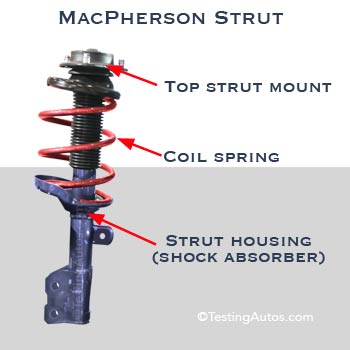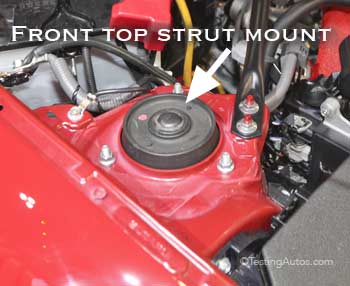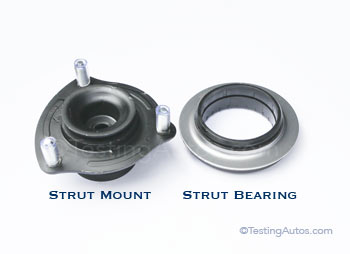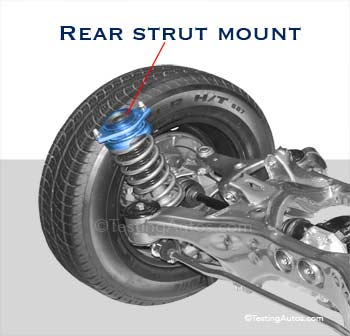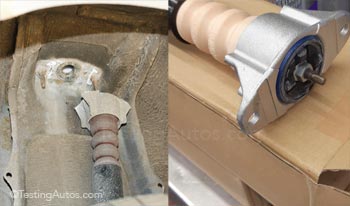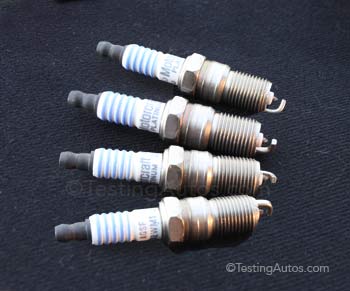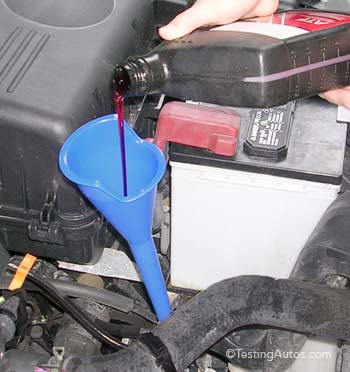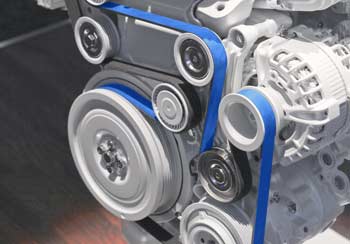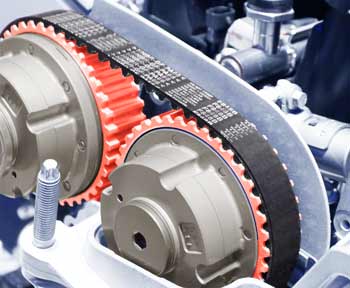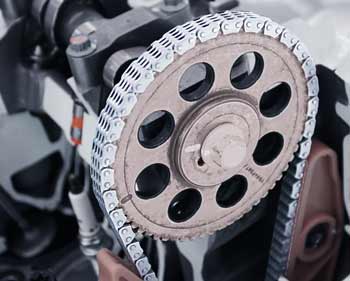Top strut mounts and upper shock mounts: when to replace?
Updated: March 04, 2020
In a car, a strut is a shock absorber that is built into an assembly with the coil spring and the top mount, called a strut mount, see the illustration. A top strut mount connects the strut to the vehicle's body or frame.
In many cars, you can see the front top strut mounts under the hood (see photo below). Shock absorber mounts serve the same purpose, scroll down to read more about them. Strut Mounts
Strut mounts have multiple roles: First, they have to keep struts firmly in place and absorb some of the shocks from road bumps.
Second, in some cars front strut mounts have strut mount bearings to allow rotation together with front wheel when turning left or right.
Third, strut mounts have to provide good sound insulation, or the road noises and vibrations will travel from the struts through the vehicle's body and into the cabin. For this reason, strut mounts have a rubber cushion, so there is no metal to metal contact between the strut and the body.
There are several reasons why strut mounts may need to be replaced. The most common is when a worn out strut mount produces a clunking or rattling noise. This type of noise could be caused by a metal plate separating from the rubber inside the mount, or by a worn-out strut bearing. It's not always easy to diagnose a noisy strut mount because the damage is not visible from the outside. Mechanics use a special tool called Chassis Ear that may help in some cases.
A bad strut mount bearing can also cause a popping or creaking noise when turning the steering wheel at slow speeds; see this video. The way the steering wheel turns may feel jerky too; like it jams and snaps free repeatedly. This happens when the grease inside the bearing dries out or when there is corrosion or wear inside the bearing. Again, this type of noise might be difficult to diagnose, because many problems can cause a similar noise.
In some cars, a strut bearing comes with a strut mount as one unit; in other cars, it can be replaced separately, although the labor is the same.
Strut mounts are also replaced if they show excessive corrosion or if the visible rubber part looks ripped or badly worn. Rear strut mounts, for example, are often replaced because of rust damage.
Is it safe to drive with a bad strut mount? This question only your mechanic can answer, because it all depends on the condition of the strut mounts.
Strut mounts are not very expensive parts, but it takes a considerable amount of labor to replace them. When struts are assembled, the coil springs are compressed under great tension. They can unwind with a lot of force and cause injury. We recommend getting this repair done in a repair shop. To replace a strut mount, a strut must be carefully disassembled using a special spring compressor. Replacing one front strut mount in an average modern car or crossover will cost from $220 to $380, plus the wheel alignment if needed.
It's not necessary to replace both strut mounts at the same time, but if one is bad, the other one might be worn out too. If struts are replaced for other reasons and strut mounts show some wear or are known to fail in this vehicle, it makes sense to replace them at the same time.
Replacing both struts together with strut mounts will cost from $650 to $900 in an average car. In some cars, the wheel alignment must be performed after replacing front strut mounts or struts. The wheel alignment will cost $50-180 extra.
Upper shock mounts
In some cars, the top ends of the rear shock absorbers are connected to the car body through upper shock mounts. They serve the same purpose as the strut mounts: to provide a connection point between the shock absorber and the car body without metal-to-metal contact.
In older cars, it's not uncommon to see upper shock absorbers mounts breaking off due to excessive corrosion like in this photo. This causes a loud knocking noise in the back of the car when driving. Obviously, it's not safe to drive like this. In some vehicles, the upper shock mount comes as a separate part; in others, it's sold as one unit with the shock absorber. Replacing a rear shock absorber in an average car will cost $140-220 for one side. Replacing only the upper shock mount will be slightly cheaper.
Read Next:
When should struts and shock absorbers be replaced?
How often should the wheel alignment be done?
When do the control arms need to be replaced?
When do coil springs need replacing in a car?
When does the tie rod end need to be replaced?
When to replace sway bar links?
When Should Tires be Replaced in a Car?
When should struts and shock absorbers be replaced?
How often should the wheel alignment be done?
When do the control arms need to be replaced?
When do coil springs need replacing in a car?
When does the tie rod end need to be replaced?
When to replace sway bar links?
When Should Tires be Replaced in a Car?
